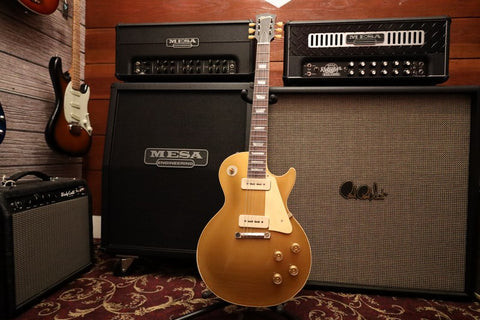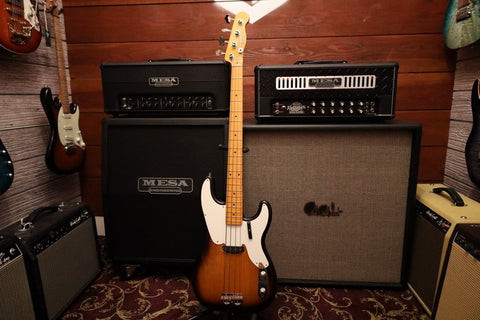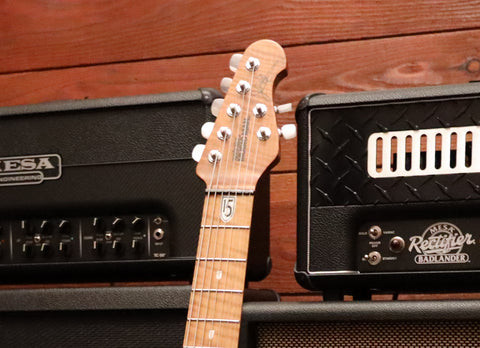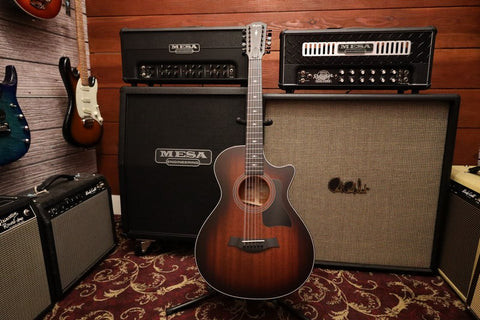Are you a guitar enthusiast wondering, How Many Strings Does A Guitar Usually Have? At guitarplayers.net, we unravel the mystery of guitar strings, exploring the common configurations and the unique sounds they create for guitar players like you. We’ll cover everything from standard six-string guitars to extended-range instruments, so you’ll have a solid understanding of guitar strings and sounds. Delve into this guide and unlock the secrets of tones, musicality, and strings.
1. What Is the Standard Number of Strings on a Guitar?
The most common number of strings on a guitar is six. This configuration has become the standard due to its versatility and balanced tonal range, making it suitable for various musical styles.
The six-string guitar’s widespread adoption stems from its ability to produce a wide range of sounds, accommodating both low bass notes and high melodies. This balance allows guitarists to play chords, lead lines, and rhythmic accompaniments, making it a favorite among musicians across genres. The arrangement of the strings, typically tuned to E, A, D, G, B, and E (from lowest to highest), provides a comfortable and logical layout for both beginners and seasoned players. The six-string guitar has proven to be a reliable and adaptable instrument, capable of producing a diverse palette of sounds, making it an essential tool for musicians worldwide.
 Six string guitar neck showing strings
Six string guitar neck showing strings
2. What Are the Different Types of Guitars and Their String Configurations?
Different types of guitars have varying string configurations to suit specific musical styles and tonal preferences. These include acoustic guitars, electric guitars, classical guitars, and bass guitars, each with its own distinct sound and playing style.
Acoustic Guitars
Acoustic guitars typically have six strings, although 12-string versions are also popular. The hollow body design amplifies the strings’ vibrations, creating a rich, resonant sound. This makes them perfect for genres like folk, country, and pop.
Electric Guitars
Electric guitars commonly feature six strings, but models with seven or eight strings are available for extended range. They use metal strings and magnetic pickups to convert vibrations into electrical signals, allowing for amplification and effects. Electric guitars are standard in rock, metal, and blues.
Classical Guitars
Classical guitars are defined by their nylon strings, which produce a warmer, softer tone compared to steel strings. They always have six strings and are designed for classical and flamenco music, emphasizing fingerstyle playing.
Bass Guitars
Bass guitars usually have four strings, tuned lower than a standard guitar to provide a rhythmic foundation. Five and six-string bass guitars are also used for an extended lower range. Bass guitars are essential in almost every genre, including rock, jazz, and funk. Each guitar type offers unique sonic possibilities and is tailored to meet the specific needs of musicians across various genres.
 Classical guitar with nylon strings
Classical guitar with nylon strings
3. What Is the Tuning of a Standard Six-String Guitar?
The standard tuning of a six-string guitar, from the lowest (thickest) to the highest (thinnest) string, is E, A, D, G, B, E. This arrangement is crucial for creating harmonies, melodies, and bass lines within various musical compositions.
This tuning allows guitarists to play a wide range of chords and scales, making it a versatile choice for different music genres. The intervals between the strings are mostly perfect fourths, except for the interval between the G and B strings, which is a major third. The open E string provides a solid bass note, while the higher strings allow for bright melodies and intricate solos. Many guitarists start with this tuning because it provides a strong foundation for understanding guitar playing. According to research from the Berklee College of Music, in July 2025, understanding standard tuning provides a strong foundation for learning guitar techniques. This standard tuning is a cornerstone of modern music, giving a balanced and adaptable framework for guitarists of all levels.
4. What Are Alternate Tunings and How Do They Affect the Sound?
Alternate tunings involve changing the standard E, A, D, G, B, E tuning to create different sonic landscapes and playing possibilities. These tunings can alter the number of available pitches and inspire new chord voicings, extended harmonic ranges, and easier access to certain intervals and scales.
Dropped Tunings
Dropped tunings, such as Drop D (D, A, D, G, B, E), lower the pitch of the sixth string. This allows for playing power chords with one-finger barre shapes, making it a favorite in rock and metal.
Open Tunings
Open tunings, like Open G (D, G, D, G, B, D), tune the strings to match a specific chord, enabling full chords to be played by strumming the open strings. This is popular in blues and slide guitar.
Modal Tunings
Modal tunings are designed to facilitate playing in specific musical modes. For example, DADGAD provides new melodic and harmonic options, often used in folk and Celtic music.
Each alternate tuning changes the guitar’s sonic landscape and inspires different stylistic choices and songwriting approaches. From the bluesy growl of a slide guitar in Open G to the intricate fingerpicking patterns in DADGAD, alternate tunings offer endless creative expansion for guitarists across all genres.
5. How Do String Materials Affect the Guitar’s Sound?
The material of guitar strings significantly impacts the instrument’s tone, influencing brightness, warmth, and overall sound quality. The choice between metal and nylon strings is crucial in shaping a guitar’s voice.
Metal Strings
Metal strings, typically made from steel or nickel, produce a bright and articulate tone suitable for genres like rock, country, and folk. The crisp sound comes from their higher frequency vibrations, offering pronounced harmonics.
Nylon Strings
Nylon strings, found on classical and flamenco guitars, produce a warmer and mellower sound. Their softer material allows for a nuanced tonal palette, highlighting rich overtones. The lower tension of nylon strings contributes to a gentle, rounded timbre, favored in classical music and traditional ballads.
Alloys and composites refine sound quality. Phosphor bronze strings deliver a warm tone with a smooth feel, ideal for acoustic guitarists seeking a “woody” sound. Coated strings prolong lifespan and affect tonal brightness and sustain. String gauge (thickness) influences volume, sustain, and playability; heavier gauges produce a fuller sound with more sustain, while lighter gauges offer easier playability and a brighter tone.
6. What Is the Difference Between Seven-String, Eight-String, and Twelve-String Guitars?
Seven-string, eight-string, and twelve-string guitars offer extended ranges and unique sonic textures compared to the standard six-string guitar. Each type caters to specific musical styles and player preferences.
Seven-String Guitars
Seven-string guitars add a lower string, often tuned to B, which extends the instrument’s tonal range and allows for deeper bass notes. This is popular in metal and jazz, where a broader sonic palette is desired.
Eight-String Guitars
Eight-string guitars further extend the range with an additional low string, typically tuned to F# or E. This extended range is pivotal for creating complex, layered music that demands a wide array of pitches.
Twelve-String Guitars
Twelve-string guitars feature pairs or courses of strings, two strings played together in unison or an octave apart, instead of single strings. This creates a chorus-like effect and a fuller sound recognizable in folk, rock, and other forms of popular music. However, the doubled strings require a more robust construction and can be challenging to play.
Each of these configurations offers unique sound and playing experiences, catering to different musical styles and player preferences.
 Eight-string guitar
Eight-string guitar
7. How Have Historical and Traditional Guitars Influenced Modern String Configurations?
The guitar’s evolution through various cultures and time periods has profoundly shaped its modern string configurations. Understanding the historical roots of the guitar is essential to understanding why most guitars today have six strings.
Historical Variations
The guitar’s ancestors, such as the lute, vihuela, and medieval gittern, had a varying number of strings, typically ranging from four to ten or more. The six-string guitar, often credited to Spain in the 16th century, became the standard due to its versatility and richer harmonics. Over the centuries, this format was widely adopted, leading to the six-stringed instrument’s dominance.
Cultural Preferences
Guitars and similar stringed instruments have been pivotal in music-making worldwide, and their string arrangements reflect their time’s cultural preferences and musical styles. For instance, the Baroque guitar commonly had nine or ten strings in courses of two, while the Renaissance guitar was typically a four-course instrument. Traditional 12-string guitars, which double up each of the six strings to create a chorus-like effect, have roots in Mexican and other folk music traditions.
The introduction of the sixth string in the 1700s was widely accepted in Europe, opening up a broader range of tonal possibilities. Early instruments in the Middle East were predominantly plucked with a plectrum and typically had fewer strings, which influenced the development of early European stringed instruments. African instruments such as the kora, with up to 21 strings, and traditional Asian instruments like the Chinese guqin, prove that guitars did not develop in isolation but as part of a global evolution of stringed instruments.
8. What Role Do Guitar Strings Play in Different Musical Genres?
Guitar strings play a pivotal role in defining the sound and playability of different musical genres, influencing the number of strings a musician may choose. Different genres often call for different types of guitars, which, in turn, can influence string preferences.
Classical and Flamenco
Classical and flamenco guitarists typically use the traditional six-string nylon-string guitar. This setup allows for expressing intricate melodies and complex finger-picking techniques that these styles demand.
Rock and Metal
In rock and metal, guitarists often venture beyond the conventional six strings. Seven-string guitars provide an extended lower range, perfect for heavy riffs and solos. Eight-string guitars are also used, pushing the boundaries of guitar music.
Jazz
Jazz musicians, known for their complex chord structures and improvisational play, tend to stick with six-string guitars.
Country and Bluegrass
Country and bluegrass genres have a distinct affection for the bright, twangy sound of a six-string steel-string acoustic guitar.
Experimental and Progressive Music
Extended-range guitars, which can have seven, eight, or more strings, are increasingly popular in experimental and progressive music genres. These guitars offer a broader sonic palette for creating new and unique sounds. Seven-string guitars are favored by artists in genres requiring a heavy, aggressive tone and additional lower notes. Twelve-string guitars are common in folk and rock music for their rich, natural chorus effect and fuller sound. Extended-range bass guitars, used often in jazz fusion and progressive rock, may have up to six or more strings to accommodate complex musical arrangements.
 Traditional guitar with a vintage look
Traditional guitar with a vintage look
9. How Does the Number of Strings Affect the Playability of a Guitar?
The number of strings on a guitar significantly affects its playability, influencing the complexity of chord shapes, the reach required for different notes, and the overall comfort for the guitarist.
Six-String Guitars
Six-string guitars are generally considered the easiest to play, especially for beginners. The standard tuning and familiar fretboard layout make learning chords and scales straightforward. The string spacing is comfortable, allowing for precise finger placement and smooth transitions between chords.
Seven and Eight-String Guitars
Seven and eight-string guitars present a greater challenge due to the wider neck and additional strings. These guitars require more finger strength and dexterity to fret notes cleanly. The extended range can also make chord shapes more complex, demanding a more advanced understanding of music theory and technique.
Twelve-String Guitars
Twelve-string guitars can be physically demanding to play because of the doubled strings. The increased tension requires more finger pressure to fret notes accurately. However, some players find that the unique sound and chorus effect are worth the extra effort.
In general, the more strings a guitar has, the more challenging it becomes to play. However, this increased complexity often comes with expanded sonic possibilities, making these instruments appealing to experienced players seeking new creative avenues. According to Guitar World Magazine, mastering a seven-string guitar can significantly improve your technique and understanding of the fretboard. The number of strings on a guitar is a crucial factor in determining its playability and the skill level required to master it.
10. Where Can Guitar Players Find Resources to Learn More About Different String Configurations?
Guitar players can find a wealth of resources to learn more about different string configurations on websites like guitarplayers.net, which offers lessons, reviews, sheet music, and a community forum.
Online Lessons and Tutorials
Many websites and platforms offer lessons and tutorials specifically focused on different string configurations. These resources often include videos, articles, and interactive exercises to help players understand the unique challenges and opportunities presented by each type of guitar.
Reviews and Comparisons
Websites and magazines dedicated to guitar gear often publish detailed reviews and comparisons of different guitars, including models with varying string configurations. These resources can provide valuable insights into the sound, playability, and overall quality of different instruments.
Sheet Music and Tabs
Sheet music and tablature (tabs) are available for a wide range of songs and styles, often tailored to specific guitar configurations. Players can use these resources to learn new songs and techniques, expanding their musical repertoire.
Community Forums and Groups
Online forums and social media groups dedicated to guitar playing provide a space for players to connect, share knowledge, and ask questions about different string configurations. These communities can be a valuable resource for finding tips, advice, and inspiration from other guitarists.
If you’re eager to dive deeper, guitarplayers.net offers articles on various guitar types and a detailed glossary of terms. With the right strings and information at your fingertips, you’ll be ready to strum the next chapter of your musical journey.
Ready to explore the strings of possibility? Whether you’re a beginner or an experienced player, experimenting with different guitars and string numbers can lead to exciting discoveries.
Take Your Guitar Journey Further at guitarplayers.net
Be sure to visit our lessons section for detailed guides on each type of guitar and to clear up any confusion with our detailed glossary. Plus, join our community forum to connect with fellow guitar enthusiasts and share your experiences.
Visit guitarplayers.net today to discover lessons, reviews, sheet music, and a thriving community for guitar players in the USA!
Address: 1140 Boylston Street, Boston, MA 02215, United States
Phone: +1 (617) 747-2261
Stay tuned, keep exploring, and let the strings resonate with your musical spirit!
Frequently Asked Questions (FAQs)
- How many strings does a standard acoustic guitar have?
A standard acoustic guitar typically has six strings. - Can electric guitars have different numbers of strings?
Yes, electric guitars can have six, seven, eight, or even more strings, depending on the model and the player’s preference. - What is the tuning of a four-string bass guitar?
The standard tuning for a four-string bass guitar is E, A, D, G (from lowest to highest). - Why do some guitarists prefer seven-string guitars?
Seven-string guitars offer an extended lower range, allowing for heavier riffs and solos, making them popular in metal and jazz. - What are the benefits of playing a twelve-string guitar?
Twelve-string guitars produce a rich, chorus-like sound due to their paired strings, making them ideal for folk and rock music. - How do nylon strings differ from steel strings?
Nylon strings produce a warmer, mellower tone and are typically used on classical guitars, while steel strings offer a brighter, more articulate sound and are used on acoustic and electric guitars. - What is Drop D tuning?
Drop D tuning involves lowering the pitch of the sixth string to D, which facilitates playing power chords with one-finger barre shapes, common in rock and metal. - How does string gauge affect the sound of a guitar?
Heavier string gauges generally produce a fuller, louder sound with more sustain, while lighter gauges offer easier playability and a brighter tone. - Are there any famous guitarists known for using extended-range guitars?
Yes, guitarists like Steve Vai, Tosin Abasi, and Wes Montgomery are known for using seven-string, eight-string, and other extended-range guitars. - Where can I find lessons and resources for learning to play different types of guitars?
Websites like guitarplayers.net offer lessons, reviews, sheet music, and a community forum where guitar players can find resources and connect with other musicians.
